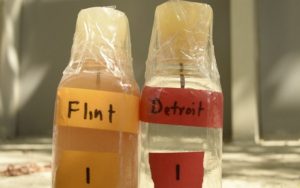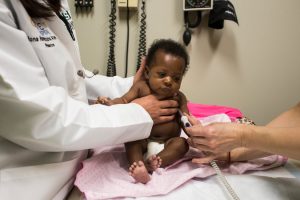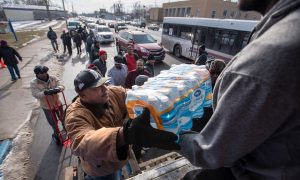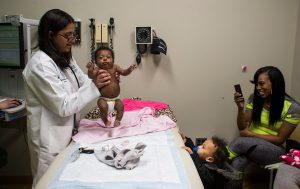Unsafe Drinking Water in Our Own Backyard: Helping the Children of Flint During This Health Crisis
“If you were going to put something in a population to keep them down for generations to come, it would be lead,” said Dr. Hanna-Attisha of the Pediatric Public Health Initiative. That is really bad news for the children of Flint, Michigan.
ACLU Michigan/ The Daily Beast
It’s estimated that 8,000 children under six years old may have been exposed to the contaminated water in Flint. These children are especially susceptible to brain and nervous system damage because their bodies are still growing. Even small amounts of lead can impair the health and growth of children. Lead exposure is associated with learning disabilities, poor motor abilities and even violent personalities. Potential health consequences are compounded in Flint because of the lack of access to adequate health services and poor living conditions.
Dr. Hanna-Attisha testing a 2-month old patient for lead poisoning. Brittany Greeson for The New York Times
The lead water crisis in Flint began around two years ago when the city switched its water supply to contaminated river water. However, the state and federal government did not begin to acknowledge the problem until recently. The neglect of the government is especially devastating because these health effects are often irreversible and untreatable in children.
Volunteers distribute bottled water at a Flint, Michigan community center. Bryan Mitchell for the Guardian
Bottled water has been donated and shipped to help the people of Flint. While bottled water helps with the immediate needs of the citizens, it won’t solve the larger problems facing children who have already drank the contaminated water. The governor of Michigan, Rick Snyder, has designated $28 million to Flint, which will allow for health services to be made available to lead-exposed children. Governor Snyder also has called upon the federal government to provide aid in getting Medicaid to every resident under 21. However, while this may be a good start, others in the field are saying that the problem is bigger and will need more aid and resources to resolve.
“We have to throw every single evidence-based resource at these kids, starting now.” -Dr. Hanna-Attisha (Photo: Brittany Greeson for The New York Times)
Doctors, like Hanna-Attisha, are working to help in the midst of the crisis by addressing the diets of the children of Flint, as well as broadening the Head Start program and others like it, which currently have wait lists in Flint. To give to the Pediatric Public Health Initiative and help its mission in providing critical interventions to the children of Flint, visit their site: https://www.cfgf.org/cfgf/GoodWork/FlintArea/WaterCrisis/tabid/855/Default.aspx
Resources:
http://edition.cnn.com/2016/01/13/us/iyw-flint-michigan-water-crisis-how-to-help/
Other Blogs
#TBT! Check out this video from our first little fundraiser we did back in 2010! We all have to start somewhere, and this is a great example of the ways YOU can be a Kitechild ambassador – hosting small get togethers in the community, donating a birthday, etc. are all great ideas! To get started, […]
Read MoreYou’ve had your black Friday, small business Saturday, and cyber Monday, now it’s Giving Tuesday, an official UN recognized day to give back amidst all the recent material frenzy. You can donate a cow for our recent farm project in Kenya, a water filter, or the gift of education for our kids in India. We […]
Read More



